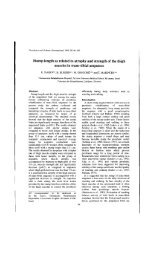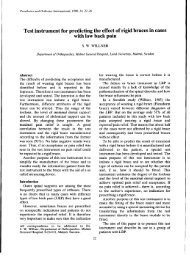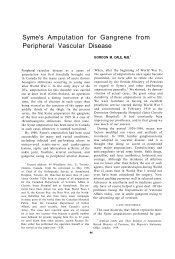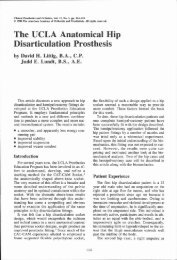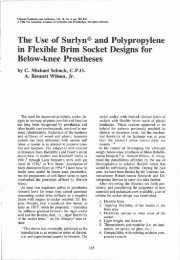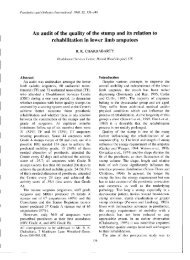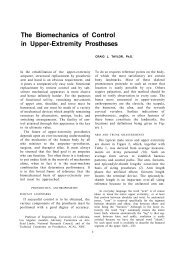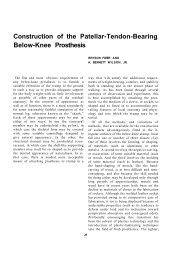Pro-Corn - O&P Library
Pro-Corn - O&P Library
Pro-Corn - O&P Library
You also want an ePaper? Increase the reach of your titles
YUMPU automatically turns print PDFs into web optimized ePapers that Google loves.
lower vertical trimlines need to be anterior to<br />
the malleoli, and carbon composite inserts can<br />
be used if necessary.<br />
Our chosen design for bivalved, weight<br />
bearing, rigid, molded AFO's is that described<br />
by Wilson, Stills, and Pritham 7<br />
with the addition<br />
of a higher posterior trimline in the popliteal<br />
area, similar to that in a below-knee prosthesis.<br />
The reduction in the range of knee<br />
flexion as a result of this higher posterior trim<br />
is a minor sacrifice for a major gain in reduction<br />
in pain. We purposely try to avoid the use<br />
of the term PTB orthosis because of its erroneous<br />
weight-bearing implications. The patella<br />
tendon is identified by mild modification of the<br />
positive model in this anatomical region, similar<br />
to but much less aggressive than in a so<br />
called "PTB" prothesis. However, there is<br />
little concentrated weight-bearing in this area;<br />
the goal of weight-bearing is equal distribution<br />
throughout the entire part of the lower leg contained<br />
within the orthosis. Perhaps the most accurate<br />
prosthetic acronym describing the<br />
weight-bearing goals of the bivalved, weightbearing,<br />
rigid, molded AFO, is the "total surface<br />
bearing" concept. In the case of an intact<br />
lower limb as is encountered in orthotics, modification<br />
of the term "to maximum surface<br />
bearing" seems appropriate.<br />
None of our patients requiring rigid AFO's<br />
has required SACH (solid-ankle cushion-heel)<br />
and rocker sole shoe modifications. We do recommend<br />
the use of shoes with soft soles constructed<br />
of Vibram® or crepe.<br />
Shoes for Arthritic Patients<br />
<strong>Pro</strong>per shoes are a vital component of orthotic<br />
management of the arthritic foot. As was<br />
stated earlier, some foot orthotic objectives can<br />
be attained with shoes of poor quality or integrity.<br />
However, properly designed and fitted<br />
shoes can only enhance the best designed and<br />
fabricated foot or ankle-foot orthoses.<br />
Our large arthritic patient population at the<br />
University of Virginia has allowed us to recommend<br />
and fit a wide variety of accommodative<br />
shoes. As we gained experience, it became apparent<br />
that we could rely on a minimum inventory<br />
of shoe types or designs. I refrain from the<br />
use of the descriptor "style" because there<br />
may be several "styles" available within a<br />
shoe design category. The categories of "design"<br />
that I refer to could be listed and described<br />
as follows:<br />
1. Thermo adjustable shoes<br />
2. Extra depth shoes<br />
3. Running shoes.<br />
Thermo Adjustable<br />
Shoes<br />
This shoe type or design is made primarily of<br />
Dermaplast®, which is a heat shrinkable Plastizote®.<br />
Known as Apex Ambulators®, there are<br />
two styles available: #1201, the simplest and<br />
most accommodative, and #1273, a more cosmetic<br />
version of the first style.<br />
Style #1201 is of black Dermaplast(tm) with a<br />
thin outer fabric covering, crepe wedge soles,<br />
Velcro® lap closure (eases donning for those<br />
Figure 8. View of various shoes useful in the management of patients with arthritis affecting the feet and<br />
ankles.



